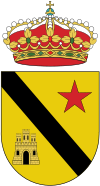Jódar facts for kids
Quick facts for kids
Jódar, Spain
|
|||
|---|---|---|---|
 |
|||
|
|||
| Country | |||
| Autonomous community |
|||
| Province | |||
| Comarca | Sierra Mágina | ||
| Area | |||
| • Total | 148.78 km2 (57.44 sq mi) | ||
| Elevation | 647 m (2,123 ft) | ||
| Population
(2018)
|
|||
| • Total | 11,805 | ||
| • Density | 79.345/km2 (205.503/sq mi) | ||
| Time zone | UTC+1 (CET) | ||
| • Summer (DST) | UTC+2 (CEST) | ||
Jódar is a city located in the province of Jaén, in southern Spain. In 2008, about 12,119 people lived there.
This area is known for its farming. Farmers here grow extra virgin olive oil, green and white asparagus, and cotton. Jódar is also famous for making things from esparto grass. It's the biggest European producer of handcrafted items like parasols for the beach, made from this special grass.
About Jódar
Jódar is found near Mount San Cristóbal. This mountain is part of the Sierra Mágina area. Jódar is the town with the most people in the Sierra Mágina region.
Nature and Weather
The city of Jódar is surrounded by several mountains. Some of the closest ones include:
- Carboneras, which is about 1,500 meters high.
- La Golondrina, standing at 1,258 meters.
- Jódar mountain, about 1,200 meters high.
- Altarillas, which is 1,066 meters tall.
Jódar has a Mediterranean climate. This means summers are warm and dry. Winters are usually cold.
A Look at History
People have lived in the Jódar area for a very long time. We know this because prehistoric remains have been found at a place called Las Quebradas.
The town of Jódar itself started around the 3rd century BCE.
During the time of al-Andalus, when parts of Spain were ruled by Muslims, Jódar was called Galdur or Xauda. The castle in Jódar is very old. Records show it existed as early as the year 860. In the 10th century, a governor named Jair Aben Xaquir declared Jódar independent. He joined a rebel leader named Omar Ben Hafsun. However, Jair Aben Xaquir later betrayed Omar Ben Hafsun. Because of this, one of Omar Ben Hafsun's helpers had him beheaded. His head was then sent to Córdoba.
Christian armies took control of Jódar in 1231. This was done by Sancho Martínez de la Torre. He was following orders from King Fernando III. Jódar was an important starting point for the battle to take the city of Ubeda.
Later, in 1485, Diaz Sanchez de Carvajal started an estate in Jódar. This was approved by the Catholic Monarchs. This system of estates continued until the 19th century, when these special privileges were ended.
Learn More
 You can find more information about Jódar for kids in Spanish: Jódar para niños
You can find more information about Jódar for kids in Spanish: Jódar para niños






